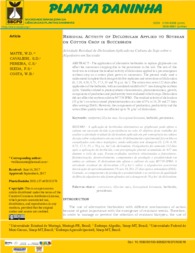Residual activity of diclosulam applied to soybean on cotton crop in succession.
Residual activity of diclosulam applied to soybean on cotton crop in succession.
Author(s): MATTE, W. D.; CAVALIERI, S. D.; PEREIRA, C. S.; IKEDA, F. S.; COSTA, W. B.
Summary: The application of alternative herbicides to replace glyphosate can affect the succession cropping due to the persistence in the soil. The aim of this work was to evaluate the residual activity of diclosulam applied to a pre-emergence soybean crop on a cotton plant grown in succession. The present study used a randomized complete block design with five replicates and seven doses of diclosulam (0, 2.19, 4.38, 8.75, 17.5, 35 and 70 g a.i. ha-1). The cotton was sown 112 days after application of the herbicide, with accumulated rainfall of 637 mm during the soybean cycle. Variables related to photosynthetic characteristics, phytointoxication, growth, components of production and productivity were evaluated in both crops. Diclosulam did not affect the soybean cultivar M7739 IPRO. The residual activity of diclosulam (35 g ha-1) on cotton caused phytointoxication at a rate of 5% at 14, 20 and 27 days after sowing (DAS). However, the components of production, productivity and the cotton fiber quality were not affected up to 70 g ha-1 of diclosulam.
Publication year: 2019
Types of publication: Journal article
Unit: Embrapa Cotton
Keywords: Carryover, Glycine Max, Gossypium Hirsutum, Herbicida, Herbicide, Herbicides, Persistence, Persistência
Observation
Some of Embrapa's publications are published as ePub files. To read them, use or download one of the following free software options to your computer or mobile device. Android: Google Play Books; IOS: iBooks; Windows and Linux: Calibre.
Access other publications
Access the Agricultural Research Database (BDPA) to consult Embrapa's full library collection and records.
Visit Embrapa Bookstore to purchase books and other publications sold by Embrapa.

